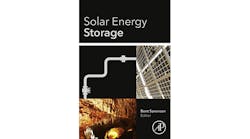Bent Sorensen from the Roskilde University in Denmark recruited 31 experts from around the world to contribute to the book Solar Energy Storage, which he edited. Sorensen says the book is intended to provide a state-of-the-art description and discussion of the energy storage issues relevant for most solar energy systems.
In the introduction, Chapter 1, Sorensen explains that this book focuses on energy storage suitable for integration into solar energy systems. One of the two areas of application for solar energy storage systems handles the obvious day-to-night storage requirement and the other is seasonal energy storage generated in summer or adjacent periods for use in winter.
Chapter 2, Solar Energy Storage, describes two ways to convert solar energy to electrical energy: Solar cells (PV technology) directly convert solar radiation energy into electrical energy; and indirect solar thermal systems convert solar radiation into thermal energy by means of solar collectors or concentrators, which then generate electricity through a conventional thermal cycle.
Chapter subjects include:
- Technical requirements of a solar electrical energy storage facility
- Options for solar electrical energy storage technologies
- Utility-scale storage technologies
- Distributed scale storage technologies—rechargeable batteries
- Economics of solar electrical energy storage technologies
The title of Chapter 3 is Innovative Systems for Storage of Thermal Solar Energy in Buildings. Included are the major technologies for heat storage in buildings:
- Sensible storage
- Latent heat storage
- Sorption heat storage systems
Solar heat absorption storage systems describe:
- Basic cycle
- Process modeling and simulations
- Process experimentation
Chapter 4, Assessment of Electricity Storage Systems, discusses the requirements of ESSs for Saudi Arabia, which includes its climate and supply-demand situation for power in that country. Then, it covers the global and local PV/Wind Power installed capacities, including:
- Chemical/electrochemical systems
- Electrical systems
- Mechanical systems
- Thermal systems
Salient features of selected ESS for renewables include:
- Pumped hydroelectricity storage
- Compressed-air energy storage
- Flow batteries
- NaS battery
- Ni-Cd battery
- Lead-acid battery
The chapter concludes that although there are various commercially available ESS systems, no single storage system meets all the requirements for an ideal ESS: maturity, long lifetime, low cost, high density, high efficiency, and environmentally benignancy.
Chapter 5 covers Storage of Solar Thermal Energy in Dependency of Geographical and Climatic Boundary Conditions. It notes that fluctuating solar irradiation (and thus solar yield) and the actual heating demand of connected consumers are rarely equal by time and magnitude. Hence, storage of thermal energy is important to balance this mismatch.
Chapter 6, Sorption Heat Storage, focuses on thermochemical heat storage, or sorption heat storage. In sorption heat storage, heat is stored in a reversible (de)composition reaction. By heating a discharged sorbent to a temperature above its equilibrium temperature, the material separates into its components (charging the sorbent). If the material is cooled to below its equilibrium temperature, the reverse reaction will take place, and the components will react again under the release of heat (discharging the sorbent).
Chapter 7: Energetic Complementarity with Hydropower and the Possibility of Storage in Batteries and Water Reservoirs. A characteristic worth considering is the possible complementarity of availability among the sources considered. A hybrid system based on two different sources may profit from their complementary availability throughout a period of one year. The subjects on complementary systems include:
- Evaluation of Complementarity in Time
- Complementarity Between Solar Energy and Hydropower
- Hydro-PV Hybrid Systems Based on Complementary Energy Resources
- Effects of Complementarity in Time
- Effects of Different Degrees of Complementarity in Time
- Effects of Different Degrees of Energy-Complementarity
- Effects of Different Degrees of Amplitude-Complementarity
- Some Real Hybrid Systems with Partial Complementarity
Chapter 8: Revitalization of Hydro Energy: A New Approach for Storing Solar Energy. Energy storage is crucial for increasing the share of energy from renewable energy source (RES) generators. This especially applies to energy from the sun and wind, which is characterized by intermittence. However, the problem with the present energy storage technologies is that they can be stored for a relatively small amount of energy, and in that sense a relatively short period of time to balance intermittent energy from RES generators (i.e., hourly, daily up to a maximum weekly value).
Pumped storage hydroelectricity (PSH) technology can significantly increase the share of RES generators in electric power systems (EPS). But precisely because of these qualities (i.e., storing the largest amount of energy), it is possible to balance summer surpluses and winter shortages of solar energy (SE). Thus, the essential characteristic of PSH technology is its storage of large quantities of energy, which allows balancing on an annual basis when weather conditions repeat. Subjects include:
- An Innovative Solution: Integration of a Solar-Hydro System
- Geosynthetics as a Prerequisite for Hydro Energy Storage
- Concept Integration of the SE-PSH System
- Optimization Model of SE-PSH System
- Impact Geosynthetics and Dynamic Charging and Discharging of PSH System
Chapter 9: Photovoltaics and Storage Plants: Efficient Capacities in a System View
- Energy Outlook
- Storage Plants in a System View
- Reference Case
- Sensitivities
Chapter 10: Economics of Solar PV Systems with Storage, in Main Grid and Mini-Grid Settings:
- Electricity Industry Economics
- PV and Storage Applications
- Possible Future Developments
Chapter 11 covers environmental and social concerns influencing the choices made by societies and individual consumers.
The final three chapters present case studies of the particular challenges that solar systems meet on remote islands and locations far from existing power grids, looking at cooking as well as basic electricity demands for communication, education, and local machinery.
More information on Solar Energy Storage by Bent Sorensen may be found on the Elsevier website at http://store.elsevier.com/ under the heading of Energy and Power.
Imprint: Academic Press
Release Date: June 18, 2015
Paperback Pages: 394
ISBN: 978-0-12-409540-3

